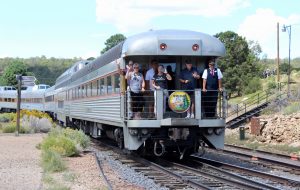Tourism boost creates growth issues for Williams.
Train travelers were treated to a snow-blanketed South Rim and photographers scored images of a century-old steam locomotive puffing smoke into the frigid air.
“We’re chugging along and only seeing more and more people coming out to visit,” said Sam Langner, Grand Canyon Railway vice president of sales. “It’s good to feel like we’re back to pre-2020 business.”
The Williams-based heritage train bounced back from a pandemic slowdown that cut its passenger count 18% in 2020. Last year, GCR was just 1,500 passengers shy of the 191,000 passengers it carried to the South Rim in 2019.
That’s good news for Xanterra Travel Collection, which owns and operates the train and has hotels on both ends of the 64-mile route between Williams and the Canyon. It’s also good for Grand Canyon Village, since the train keeps roughly tens of thousands of cars out of the congested National Park each year.
GCR’s rebound is also good for the economy of Williams, known as tthe Gateway to Grand Canyon since 1902. Through the past 34 years, the railway has been a key driver of the Williams economy.
“It’s been positive because [GCR] helped put Williams on a stable financial basis,” said Williams Mayor Don Dent, adding that it has extended the tourist season beyond the summer months.
Preservation of the city’s historic district and Route 66 road trippers have also been a factor in a renaissance of Williams since Interstate 40 bypassed the town almost 40 years ago.
But the prosperity from the railway’s growth and other new attractions — Bearizona and Canyon Coaster Adventure Park — have created challenges for Williams. That includes a shortage of worker housing and a sewage treatment system that’s nearing its capacity.
The city’s sewer plant serves a population of about 3,200 residents, but at times it also serves close to 3,200 overnight visitors in hotels, recreational-vehicle parks and 200 vacation rentals, Dent said.
“We’re about to max out our sewer plant,” and the city is likely to enact a moratorium on sewer hookups within the next 60 to 90 days, he said.
That will stall development at a time when Williams needs new housing.
GCR is one of the city’s largest employers, with 350 workers. Some commute from Flagstaff, Parks, Ash Fork and Chino Valley. The railway’s main office is in the 1908 Williams Depot and Fray Marcos Hotel. A satellite office is in Flagstaff.
Passenger service to the South Rim ended in 1968. GCR revived rail service in 1989 with modest traffic. It carried 84,203 passengers in 1991. That increased steadily to 238,380 by 2006, according to a National Park report.
Mayor Dent, 71, a Williams native, said the mountain town suffered economically when it was the last community on Route 66 bypassed by I-40 on Oct. 13, 1984. It was the day the music of the Mother Road died. Locals no longer had to worry about semis barreling through town, but traveler spending declined at Williams gas stations, restaurants and motels.
Things looked especially grim when plans emerged to tear up the railroad tracks to Grand Canyon. Williams got a court injunction to halt salvage of the rails and ties, Dent said.
Luckily, a pair of angel investors, Max and Thelma Biegert, acquired the remaining railroad assets and developed GCR. But it was a struggle.
“I don’t think they turned a positive nickel for a number of years,” Dent said of the Biegerts, adding that GCR’s new Williams hotel in 1995 improved its bottom line.
Passenger traffic doubled to 170,481 from 1991 to 2001 and increased another 40% by 2006.
Xanterra bought GCR from the Biegerts in 2007. The company, which operates lodging at Grand Canyon and other national parks, has grown GCR into one of the nation’s most popular heritage trains.
“The [Grand Canyon] National Park is the magnet that brings folks in,” Langner said. “On the sustainability side of things, we keep just over 60,000 cars out of Grand Canyon National Park annually.”
That is 5% of the 1.2 million vehicles that entered the park last year. But Xanterra has other sustainability initiatives.
Last year, Xanterra completed the $35 million Maswick South Lodge, adding 120 rooms. It was the first new hotel in the park in a half century. The lodge is 40% more energy efficient than the buildings it replaced, and uses reclaimed water for landscaping, Langner said.
GCR also retrofitted its steam locomotive in 2009 to run on recycled vegetable oil.
“It even kind of smells like French fries as it’s chugging along,” he said. “What always surprises folks about the railway experience is just how you are, in a sense, transported back in time. We’re so used to plugging into our phones, putting in the headphones and not paying attention. This is an experience that forces you to really take it all in.” QCBN
By Peter Corbett, QCBN
Courtesy Photo: The steam-powered train, shown in this 2019 photo, is chugging back to pre-pandemic ridership levels, boosting the Williams economy and keeping tens of thousands of cars out of the Grand Canyon National Park.







Leave a Reply